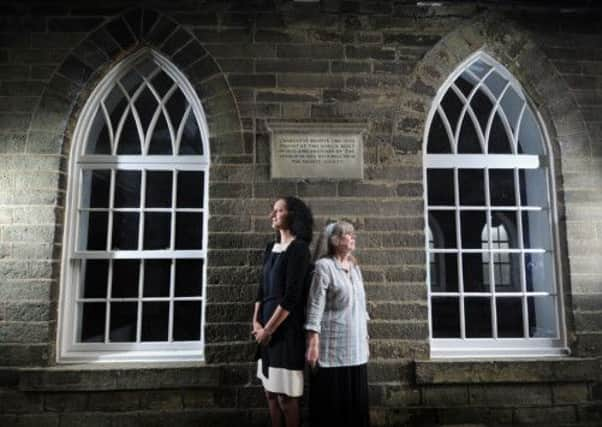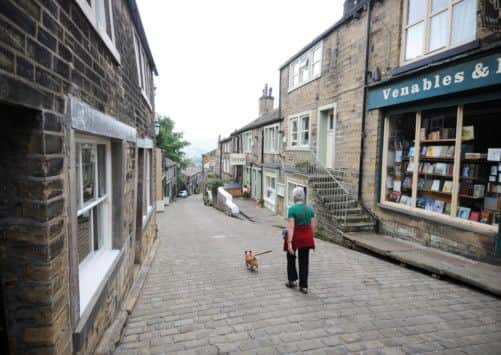In Brontë footsteps


Perched at the top of a steep hill and surrounded by the desolate ‘wuthering’ moors of the north Pennines, Haworth will forever be associated with the Brontës.
The three sisters are the reason why thousands flock to the town each year, but in 2010 it was added to English Heritage’s “at risk” register amid fears the rich history of the town was being lost behind cluttered streets and modern shop fronts.
Advertisement
Hide AdAdvertisement
Hide AdIn the intervening years, much has been done to reverse the decline and it’s one of the reasons why the conservation organisation, along with the likes of the Brontë Society and Bradford Council, has launched a new walking trail around Haworth. “The idea of the trail was that it would highlight areas of the town that people don’t know so well,” says Deborah Wall of English Heritage. “And we wanted to give people a sense of what it would have been like when the Brontës were here.” Featuring 27 places of interest, it’s designed to take visitors a little off the beaten track and prove that there is more to the place than just Jane Eyre.


“The Brontës are just a part of Haworth,” says Christine Went, heritage and conservation officer with the Brontë Society. “And they saw their own history as much bigger than that. Haworth was an important part of the textile industry in the 19th century but when Elizabeth Gaskell wrote Charlotte Brontë’s biography she portrayed the sisters as living in an isolated place. Charlotte, for her own reasons, perpetuated that idea – I think she was trying to make excuses for the writing of the novels which had been poorly received by some.”
At the time Haworth was quite a prosperous place and, situated only a few miles from Keighley, was certainly not completely removed from society and culture. Haworth itself had a Philosophical Society, formed in 1780 and later a Mechanics Institute was established in the village offering a library, newsroom and lecture hall. Both Charlotte and Patrick Brontë were strong supporters of the Institute which moved in 1853 to new premises, now the Villette café in Main Street. “There was a lot going on,” says Christine. “There was the brass band, formed in 1854, and there were orchestral and choral concerts – the Messiah was performed in the church for the inauguration of the new organ. Most people in the village had multiple occupations, mostly connected with the textile industry. So you would have a farmer who was also a handloom weaver or an ironmonger who was also a yarn twister.”
A lot of the work was done in factories – the biggest in Haworth was Bridgehouse Mills in the valley below the village and features on the trail – but some of the processes, like woolcombing, could be carried out in people’s homes.
Advertisement
Hide AdAdvertisement
Hide AdAnother big industry in Haworth was beers, wines and spirits – reflected in the fact that for a relatively small place there were four inns.
“The industry was mostly in the hands of the Thomas family,” says Christine. “They had a lot of the property at the top of the village and owned and managed all four of the pubs. There is a small group of cottages – Gaugers Croft – which were known locally as ‘Brandy Row’ because the Thomases, who owned them, would give bottles of brandy to their tenants for Christmas.”
One of the sons, Enoch Thomas, was a drinking partner of Branwell’s and died of inflammation of the liver within a year of his friend. His widow went on to marry the local physician Dr John Wheelhouse who attended both Anne and Branwell in their last months (Emily refused to see him but he signed her death certificate) and about whom Branwell once wrote a scurrilous piece of doggerel, one of his last poems.
“In it he appears to be praising Wheelhouse but he is actually highlighting his faults,” says Christine. “The doctor had obviously upset him in some way – he had probably advised him to stop drinking.”
Advertisement
Hide AdAdvertisement
Hide AdThe new trail and and booklet are part of a wider project to preserve and enhance Haworth for future generations. The conservation project has involved replacing frontages of shops and businesses in the village in keeping with the 19th-century heritage of the village, maintaining the cobbles, or setts, on the Main Street and installing new windows into the old Schoolhouse, which played such an important part in the Brontë siblings’ lives. It was built in 1832 as a Sunday school with funds from the National Society and from public subscriptions generated through the efforts of Patrick Brontë.
“Charlotte, Anne and Branwell would all have taught at the Sunday school – there is some doubt about whether Emily did because she had strong views of her own on religion,” says Christine.
“Every year the Brontës would hold a tea party for the Sunday school teachers at the Parsonage – most of the other teachers were mill girls.”
Another point of interest on the trail is the home of carpenter William Wood who made much of the furniture still in the Brontë Parsonage and was employed by Patrick to do odd jobs including painting and decorating. “He also made all the Brontës’ coffins,” says Christine. “And he made cases for Barraclough clocks – the Barraclough family lived in Haworth. There is a Barraclough clock in the Parsonage and Ellen Nussey, Charlotte’s great friend, wrote how, after the death of her siblings, Charlotte would sit alone in the parlour with just the sound of the clock ticking.”
Advertisement
Hide AdAdvertisement
Hide AdChristine and Deborah both acknowledge that the legacy of the Brontës is one of the main attractions for visitors to Haworth but they hope the trail and booklet bring out other aspects. “Really we want to broaden people’s understanding of its history,” says Deborah. “Down to a certain point on Main Street not much has changed really – Charlotte could walk up the hill today and still recognise it.”
Haworth Village of the Brontës’ Trail Guide is free and available from Brontë Parsonage Museum, the Tourist Information Office and other shops in the village.